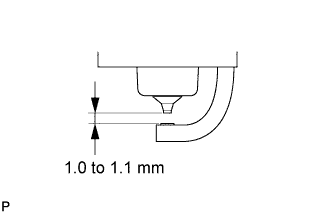Ignition System -- On-Vehicle Inspection |
- NOTICE:
- In this section, the terms "cold" and "hot" refer to the temperature of the coils. "Cold" means approximately -10°C (14°F) to 50°C (122°F). "Hot" means approximately 50°C (122°F) to 100°C (212°F).
| 1. INSPECT IGNITION COIL ASSEMBLY |
Check for DTCs.
- NOTICE:
- If any DTC is present, perform troubleshooting in accordance with the procedures for that DTC.
Check that sparks occur.
Remove the intake air surge tank (CAMRY_ACV40 RM000001IR3003X_01_0002.html).
Remove the No. 1 surge tank stay (CAMRY_ACV40 RM000001EFJ00AX_01_0004.html).
Disconnect the 6 ignition coil connectors and remove the 6 bolts and 6 ignition coils.
Using a 16 mm (0.63 in.) plug wrench, remove the 6 spark plugs.
Disconnect the 6 fuel injector connectors.
Install the spark plugs to each ignition coil, and connect the ignition coil connectors.
Ground the spark plugs.
Check if a spark occurs at each spark plug while the engine is being cranked.
- NOTICE:
- Be sure to ground the spark plugs when checking.
- Replace the ignition coil if it receives an impact.
- Do not crank the engine for more than 2 seconds.




Perform the spark test according to the flowchart below.
Check that the ignition coil connector is securely connected.
- Result:
Result Proceed to NG Connect securely OK Go to next step
Perform a speak test on each ignition coil.
- Replace the ignition coil with a normal one.
- Perform the spark test again.
- Result:
Result Proceed to OK Replace ignition coil NG Go to next step
- Replace the ignition coil with a normal one.
Check the power supply to the ignition coil.
- Turn the ignition switch to the ON position.
- Check that there is battery voltage at the ignition coil positive (+) terminal.
- Result:
Result Proceed to NG Check wiring between ignition switch and ignition coil OK Go to next step
- Turn the ignition switch to the ON position.
Check the VVT sensor output voltage.
- Result:
Result Proceed to NG Check that there is resistance between ECM and VVT sensor. If there is no resistance, replace VVT sensor. If there is resistance, repair wiring between VVT sensor and ECM. OK Go to next step
Measure the resistance of the crankshaft position sensor.
- Standard resistance:
Temperature Specified Condition Cold 1,630 to 2,740 Ω Hot 2,065 to 3,225 Ω
- Result:
Result Proceed to NG Replace crankshaft position sensor OK Go to next step
Check the IGT signal from the ECM.
- Result:
Result Proceed to NG Check ECM (CAMRY_ACV40 RM000000XH401HX.html) OK Repair wiring between ignition coil and ECM
Using a 16 mm (0.63 in.) plug wrench, install the spark plugs.
- Torque:
- 18 N*m{184 kgf*cm, 13 ft.*lbf}
Install the 6 ignition coils with the 6 bolts and connect the 6 ignition coil connectors.
- Torque:
- 7.5 N*m{76 kgf*cm, 66 in.*lbf}
Connect the 6 fuel injector connectors.
Install the No. 1 surge tank stay (CAMRY_ACV40 RM000001EFH00AX_01_0004.html).
Install the intake air surge tank (CAMRY_ACV40 RM000001IR0005X_01_0003.html).
| 2. INSPECT SPARK PLUG |
- NOTICE:
- Never use a wire brush for cleaning.
- Never attempt to adjust the electrode gap on a used spark plug.
Check the electrode.
Using a megohmmeter, measure the insulation resistance.
- Standard insulation resistance:
- 10 MΩ or higher
- HINT:
- If the result is 10 MΩ or less, clean the plug and measure the resistance again.
- If a megohmmeter is not available, perform the following simple inspection instead.
 |
Alternative inspection method:
Quickly accelerate the engine to 4,000 rpm 5 times.
Remove the spark plugs.
Visually check the spark plug.
If the electrode is dry, the spark plug is functioning properly. If the electrode is damp, proceed to the next step.
Check the spark plug for any damage to its threads and insulator. If there is damage, replace the spark plug.
- Require spark plug:
Manufacturer Spark plug type DENSO made FK20HR11
- NOTICE:
- Use only the listed spark plug or equivalent to ensure engine performance and smooth driveability.
Check the spark plug electrode gap.
- Maximum electrode gap for used spark plug:
- 1.4 mm (0.055 in.)
- Electrode gap for new spark plug:
- 1.0 to 1.1 mm (0.039 to 0.043 in.)
 |
Clean the spark plugs.
If the electrode has traces of wet carbon, clean the electrode with a spark plug cleaner and then dry it.- Standard air pressure:
- 588 kPa (6 kgf*cm2, 85 psi)
- Standard duration:
- 20 seconds or less
- HINT:
- Only use the spark plug cleaner when the electrode is free of oil. If the electrode has traces of oil, use gasoline to clean off the oil before using the spark plug cleaner.
 |